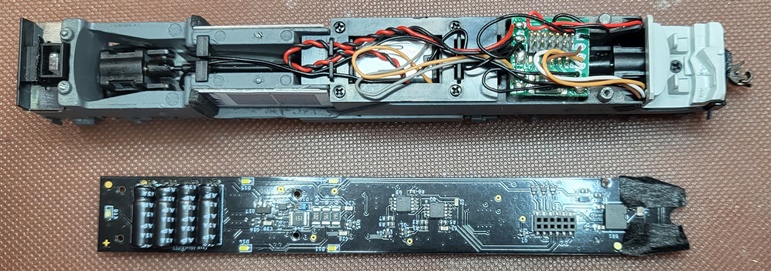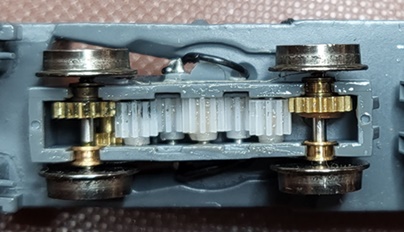
ALC-42 Charger -


ALC-42 Charger -

Introduced: 2022 (SC-44) and 2024 (ALC-42)
These smooth running and gorgeous looking models all come with TCS "WOWSound" decoders. And WOW, is that WOW ever well deserved! But more on all that later. The two models are essentially the same, just with some minor differences in the shell detailing and lighting features (as per the two prototypes). Internally, the models are identical.
The chassis consists of one big hunk of metal (IE, it is not split-frame). All eight wheels provide pickup (by way of wired wheelback wipers). Each truck has two wires that conduct current to a small / free-floating PC board that sits over the forward driveshaft and behind the cab interior detail. The decoder is screwed to the top of the chassis and connects to the main PC board via a proprietary 12-pin (6x2) interface. Wires from the main PC board transfer current to the motor and to the speaker. Additional wires transfer current to the headlight / ditch light / marker light LED board mounted to the front of the chassis. LEDs for the strobe lights, backup light, corridor lights and rear marker lights are mounted on the decoder board. Rectangular corridor details are attached to either side of the chassis.

The motor is a closed-sided can (and presumably five-pole / skew-wound). Each motorshaft is equipped with a small flywheel. Plastic driveshafts with dogbone / notched-cup U-joints spin the wormshafts. The brass worms mount inside of the tops of the swiveling truck towers.

All four axles are geared. The gearing is a mixture of brass and white plastic. Overhand hooks on the tops of the truck towers hold the trucks loosely in the chassis. Consequently, you'd need to unclip the plastic lids from the trucks in order to get them out. As delivered, the gearing is lightly lubricated (or at least it was on my example). My ALC-42 did have a bit of whine to it when running in reverse, but popping the tops off the trucks and adding some lube took care of that issue. The axles run through brass bushings that seat inside of cutouts in the trucks (a feature that I don't think I've ever seen on a diesel model before).

The speaker is rectangular and loosely seated inside of the plastic fuel tank (with the sound projecting downward through holes in said fuel tank). The fuel tank is screwed to the bottom of the chassis. The wheels are blackened and low-profile (no problems on Atlas Code-55 rails). There are no traction tires. No problems on sharp (9.75" radius) curves. Couplers are chassis-mounted E-Z Mates (Rapido-style replacement couplers are included in the box should you want to go that route).

The shell is plastic and features numerous add-on detail parts. See-through side screens are provided for the corridor lighting.

As per usual, F0 controls the directional headlight and the backup light. To control the other lighting features you need to put the decoder into "Light Mode". You do this by hitting F8 twice in quick succession to cycle between Function Page 1, Function Page 2, Function Page 3 and Light Mode. Helpfully enough, the decoder will audibly tell you which mode you've entered after each double-click of F8. Once in Light Mode, F3 controls the ditch lights, F5 controls the strobe lights, F6 controls the marker lights, F7 dims the headlight, F9 controls the corridor lights and F11 controls the red emergency strobe. Note that the strobe lights will only come on if the ditch lights are on, the headlight is at full brightness and the locomotive is set to move in the forward direction. Also note that the strobe light feature is not available on the ALC-42.
Performance on these locomotives is simply sublime. They run smooth as butter and whisper-quiet at all throttle levels. The top-end speed is realistic and the slow speed creep is "one tie at a time". Pulling power is outstanding, with mine able to haul thirteen 85' passenger cars and a track cleaning car like they're not even there. The sound is nicely rendered and decently robust. And OMG, the keep-alive feature on the decoder is beyond amazing. Given all those giant capacitors, you can pick this thing up off the rails and it will continue running for several seconds afterwards. As an experiment (one that I would never even try with any other brand of locomotive), I took my ALC-42 out of the box, put it right on track that hadn't been cleaned in weeks, and sent it off at speed step 1. And amazingly enough, it proceeded to run for 24 hours without so much as a single hiccup! Add in the outstanding looks and the amazing lighting features and it all adds up to an absolute homerun for Bachmann.
Locomotive Features -
Bachmann's DCC sound-equipped N Scale SC-44 Charger uses Siemens Mobility's original design documentation and sound files. This model includes a TCS WOWSound CD-Quality 16-bit 44,100Hz decoder with Audio Assist for easy configuration without programming CVs and a Keep-Alive device for uninterrupted operation, even over dirty track. The WOWSound diesel-electric locomotive sound package includes a horn, bell, prime mover, start-up/shutdown, compressor, cooling fan, coupler close/release, brake release and application, crew alert, grade crossing quill, departing and arriving station announcements, and more.
- Siemens-approved design
- DCC sound-equipped for sound, speed, direction, and lighting control
- Keep-Alive device that keeps the engine running during power interruptions due to dirty track or loss of electrical contact
- Voice-guided Audio Assist programming tool for easy set-up of almost all decoder functionality
- Dual-mode NMRA-compliant decoder
- Directional headlights
- Interior corridor work lights
- Roof-mounted strobe lights, per prototype
- Marker lights
- Steady/alternate flashing ditch lights
- Die-cast frame
- Separately applied detail parts
Shell Removal -
The shell is held in place courtesy of four sticky-outy nubs on the chassis that seat inside of recessed dimples in the shell. In theory, you should be able to remove the shell by simply using four toothpicks (or whatever) to free the nubs from the dimples and then lifting the shell up and off. However, it's a very tight fit though, and what I wound up doing was sticking a small screwdriver between the shell and the protrusion off the front of the fuel tank and then using that to pry upwards on the shell. Once you get things started it's pretty easy to finish the job.
Grade: A+ (no, I don't normally give out plusses and minusses, but this one absolutely earned it)